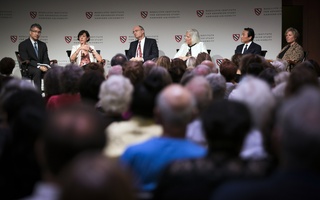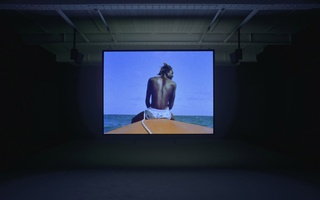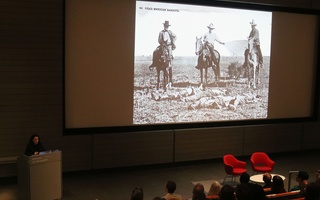{shortcode-7da74a80f2f03fb83de0264fd98b6a5af3f33150}
“Far from affording artists continuous inspiration, mass-media sources for art have become a dead end,” art critic Robert Hughes wrote in 1990. Hughes lamented creative production’s submission to the immaterial, to the mind-numbing spectacle of television. Yet 25 years later, even with the advent of the internet and the further absorption of everyday experience into the disembodied realm of the digital, the contemporary Japanese artistic collective teamLab sets out to push the bounds of media art.
teamLab, whose multimedia installation “What a Loving and Beautiful World” opened at the Radcliffe Institute for Advanced Study on Friday, Oct. 16, engages with this question of the expressive potential of digital media. In the installation space, Japanese characters float on gallery walls rendered luminous veils of color by light projections. When the viewer reaches out to touch a character, the symbol transforms into the image it represents: Silver waves ripple out from the point of contact with the character for “sea,” and pink cherry blossoms burst from the character for “flower.” As more visitors enter the space, images whirl across the walls, then subside. Within the installation, the boundaries between text and image, nature and culture, spectator and actor are constantly in flux.
Through digital media, teamLab’s artists, calligraphers, programmers, and engineers create a participatory visual environment that is both playful and meditative. “teamLab demonstrates what is possible when people with different kinds of expertise—in the arts, engineering, computer science, robotics, architecture, different areas of design—come together to solve artistic problems,” writes Yukio Lippit, professor of History of Art and Architecture at Harvard and the exhibition’s curator, in an email.
Meg Rotzel, the Radcliffe Institute’s Arts Program Manager and a practicing artist, believes that the immersivity of teamLab’s installation renders it uniquely compelling. “I’m happiest when I’m really in my work, when I’m thinking and making simultaneously,” she says. “When I go to a museum, normally I feel like I’m here and the work of art is there, and there’s a separation. But with ‘What a Loving and Beautiful World,’ you can see whole groups of people just playing in the art, within the space of the work of art.”
Hughes feared the passivity enforced by media spectacle, but teamLab uses digital media to invite the viewer to participate in the art’s making. The gallery acts as a canvas upon which the viewer inscribes his or her curiosity. Because the animation responds to the actions of viewers, the possibilities for visual variation are endless: The installation will never look the same twice. Lippit says that he appreciates the work’s capacity to give visible form to the viewer’s thoughts. “I really enjoy standing in the room and doing nothing. Somehow, the work responds,” he writes. “In theory it is supposed to be interactive and ‘triggered’ by the movements of viewers, but the installation somehow takes on new moods and can quicken its metabolism even if one does nothing, generating an uncanny sensation. It is like a mindscape.”
Within the dreamlike gallery space, teamLab weaves together calligraphy and computer-generated images, the expressive gesture of the artist’s hand and the pixel, traditional artistic practice and modern digital technology. Melissa McCormick, Harvard professor of East Asian Languages and Civilizations and Lippit’s wife, says that teamLab’s work engages with both the conditions of contemporary life and with artistic precedent. “Traditional Japanese painting is radical by many standards: It uses a multidimensional and shifting perspective, [it] folds time into spatial representation, and its formats are immersive and anticipate the movement and touch of the viewer,” McCormick writes in an email. “These are all things that have come to characterize digital art made in our current age...but teamLab’s work emphasizes their connection to art in the past and encourages new ways of thinking about links between the science of perception, consciousness, and artistic representation.”
She adds that teamLab’s work has resonance beyond the field of art history. “It would be hard to find a better example of the kind of visually stunning and even poignant results that can emerge through an integration of art and science, something in which many on this campus are thoroughly engaged,” she writes.
Lippit also emphasizes the potential of the work to broaden students’ experience of the arts. “It is not often that Harvard exhibits contemporary artists from Japan or Asia, and the exhibition expands the purview of the arts featured here,” he writes.
The installation “What a Loving and Beautiful World” will be on view in the Johnson-Kulukundis Family Gallery in Byerly Hall in Radcliffe Yard until Nov. 14.
—Staff writer Elizabeth C. Keto can be reached at elizabeth.keto@thecrimson.com.Read more in Arts
Artist Spotlight: Marlom MeirellesRecommended Articles
-
The Field Guide: Art in BostonIN THE SOUTH END BROMFIELD GALLERY 560 Harrison Ave., 4th Floor (T: Broadway) Wed-Sat: 12-5 p.m. 617-451-3605 This stalwart cooperative
-
Art Created by Tutor Stolen from PfohoA little over a month ago, a piece of art from a six-piece installation created by Pforzheimer tutor Omobolaji O. Ogunsola ’10 was stolen from its Moors Hall home.
-
 Boston Area Museum Directors Discuss Civic Institutions at Radcliffe
Boston Area Museum Directors Discuss Civic Institutions at Radcliffe -
 Steve McQueen’s 'Ashes'
Steve McQueen’s 'Ashes' -
 Teresita Fernández Talks Landscape and Intimacy with Yard Art Installation
Teresita Fernández Talks Landscape and Intimacy with Yard Art Installation













